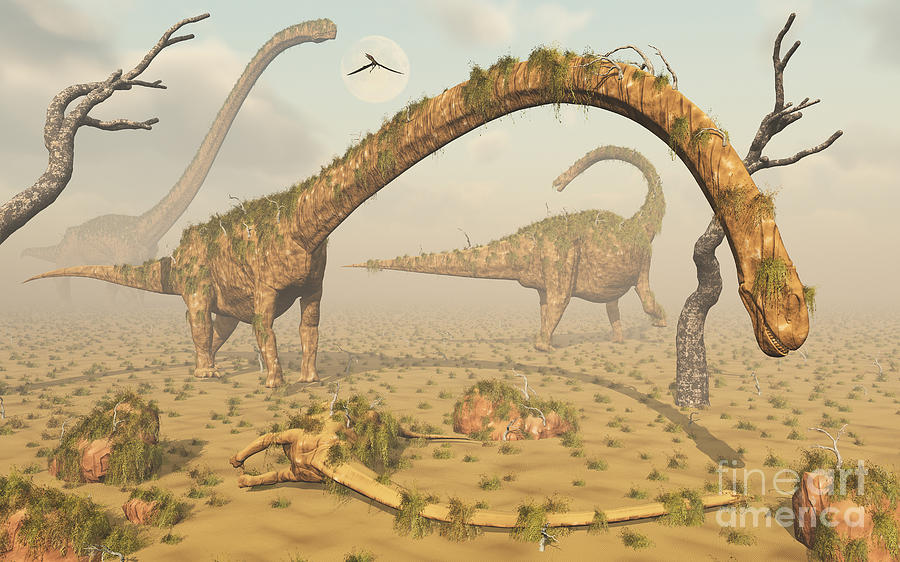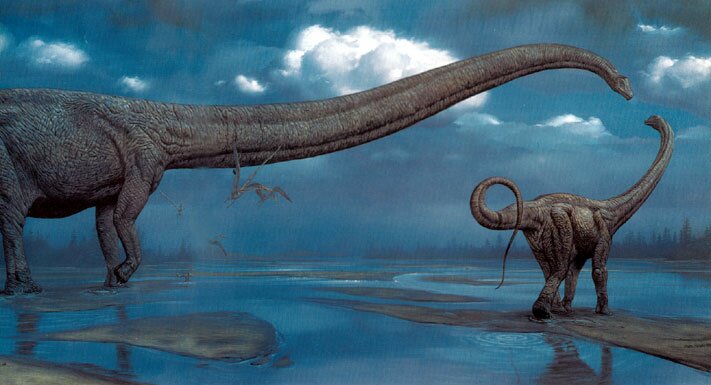[Recent Entries][Archive][Friends][User Info]
Below are the 4 most recent journal entries recorded in the "Сообщество, посвящённое ра" journal:| November 9th, 2012 | |
|---|---|
| 05:55 pm [industrialterro] [Link] |
Omeisaurus Omeisaurus (meaning "Omei lizard") is a genus of sauropod dinosaur from the Middle Jurassic Period (Bathonian-Callovian stage) of what is now China. Its name comes from Mount Emei, where it was discovered in the lower Shaximiao Formation of Sichuan Province. Like other sauropods, Omeisaurus was herbivorous and large. It measured 10 to 15.2 metres (30 to 50 ft) long and 4 metres (12 ft) high, and weighed 4 tons. Omeisaurus was first described in 1939. It was named after the sacred mountain Omeishan, which is where the first fossil example of Omeisaurus was found. Most skeletons of Omeisaurus were found in the 1970s and 1980s, during the great “Chinese dinosaur rush”. There have been six species of Omeisaurus named so far: O. junghsiensis, O. changshouensis, O. fuxiensis, O. tianfuensis, O. luoquanensis, and O. maoianus. All of these but the last were named after the locations where they were found. O. fuxiensis was the smallest species, measuring around 35 feet (11 m) long. O. tianfuensis had the longest neck of the genus, around 30 feet (9.1 m) long. The only dinosaur with a longer neck was Mamenchisaurus. A club tail fossil discovered in the same bone bed as the Omeisaurus fossils was thought to belong to this genus, but is now believed to belong to a large specimen of Shunosaurus. Mounted skeletons of Omeisaurus are on display at the Zigong Dinosaur Museum in Zigong, Sichuan Province and at Beipei Museum, near Chongqing, both in China. It was once classified as a member of the Cetiosauridae family, which had long been a wastebasket taxon. The species O. fuxiensis is sometimes confused with Zigongosaurus, but the two are based on different material despite having the same species name. Omeisaurus is presently counted as a member of the Omeisauridae, Mamenchisauridae, or Euhelopodidae. The general linkage of the genus with Mamenchisaurus et al. is the basic theme of including it in the omeisaurid or mamenchisaurid families. However, Omeisaurus is similar to many non-mamenchisaurid Chinese eusauropods classified as euhelopodids.
Репродукции (1, 2, 3, 4, 5, 6, 7, 8, 9, 10):
( Read More ) Ископаемые останки и реплики (1, 2, 3, 4, 5, 6, 7, 8):
( Read More ) Tags: Вымершие рептилии, Юра, авеметатарзалии, архозавроморфы, архозавры, диапсиды, динозавроморфы, динозавры, завроподоморфы, завроподы, маменчизавриды, ящеротазовые |
| November 5th, 2012 | |
| 07:19 pm [industrialterro] [Link] |
Mamenchisaurus Маменчизавр (Mamenchisaurus) — род позднеюрских травоядных динозавров, существовавший 150—145 млн лет назад (последняя треть юрского периода). Обнаружен на территории современного Китая. Отнесён к подотряду зауроподы. Является динозавром с самой длинной шеей, которая, по некоторым данным, достигала 15 метров в длину. Название Mamenchisaurus означает "ящерица из Мамэньси", от пиньинь «Mǎménxī» — Мамэньси и греческого «saurus» - ящерица. Первоначально решили назвать динозавра по месту находки - близ местности Маминси (пиньинь Mǎmíngxī) в провинции Сычуань. Однако в результате ошибки, допущенной Янгом, вместо Маминси было указано имя Мамэньси. Маменчизавр был открыт в 1952 при строительстве дороги в Сычуане, Китай. Части окаменелого скелета изучал и дал название виду в 1954 известный китайский палеонтолог профессор Янг. Первый экземпляр был 22 метра в длину. И половина из этой общей длины приходилась на шею, что делает маменчизавра самым длинношеим животным, когда-либо существовавшим на Земле. Шея маменчизавра состояла из 19 позвонков (следует заметить, что ни у какого другого известного динозавра стольких шейных позвонков не имелось). Есть предположения, что взрослые особи могли достигать 25 метров в длину. В 1987 году были обнаружены различные разновидности маменчизавра (M. hochuanensis) с шеей длиной 15 метров. Тот факт, что первые останки маменчизавра были найдены на месте строительства, стал причиной того, что профессор Янг дал виду название Mamenchisaurus constructus (от англ. construct — строить). Другие виды маменчизавров: M. anyuensis He, Yang, Cai, Li & Liu, 1996 M. constructus Young, 1954 M. fuxiensis Hou, Zhao & Chu, 1976: Неполный скелет, включающий части черепа. Вначале был назван зигонгозавром. Возможно, относится к другому роду. M. hochuanensis Young & Zhao, 1972: Четыре неполных скелета. M. sinocanadorum D. Russell & Zheng, 1994: Неполный череп, отдельные кости. Возможно был самым большим, достигая 26 метров в длину. M. youngi Pi, Ouyang & Ye, 1996: Mamenchisaurus youngi был найден возле города Зигонг провинции Ксинмин в Сычуане в 1989 г. Скелет данного вида достигает 16 метров в длину с 6,5-метровой шеей, что делает особей данного вида сравнительно небольшими по сравнению с особями других видов. Вид был назван в честь профессора Янга. Mamenchisaurus ( Mamenchisaurus was first discovered in 1952 on the construction site of the Yitang Highway in Sichuan, China. The partial skeleton fossil was then studied, and named Mamenchisaurus constructus in 1954, by the renowned Chinese paleontologist Professor C. C. Young. The type specimen had an incomplete neck with 14 vertebra preserved and none of these were complete . M. constructus was estimated at 13 m (43 ft) long. In 1972, a second species of Mamenchisaurus was discovered (M. hochuanensis) with a neck that reached up to 9.3 m (31 ft) in length. This species had a complete neck preserved which contained 19 vertebrae. In 1994, Sauroposeidon was discovered in the United States, with a neck estimated to be between 10.5 and 11.5 meters (34.5–37.5 feet) long, though its neck did not exceed that of the previously known Supersaurus, with a neck reaching 13–14 meters (42.5–46 feet). In 1993, M. sinocanadorum was described; this species possessed the longest cervical rib of any described sauropod dinosaur, measuring 4.1 m (13.5 ft). This is longer than the longest Sauroposeidon cervical rib, which measures 3.42 m (11.2 ft). In 2001, another M. hochuanensis specimen was described. It had skull, pectoral girdle and forelimb material preserved, all of which were missing from the holotype. It was also found with four fused tail vertebra, which have expanded neural arches and taller neural spines, that belong at the tip of the tail. It’s thought that these could be a weapon, such as a tail club, or a sensory organ. Other Chinese sauropods, Shunosaurus and Omeisaurus, are also known to have had ’tail clubs’ but they differ in shape to that of M. hochuanensis. Половину от общей длины тела маменчизавра составляла тонкая шея, которая была длиннее трех поставленных бампер к бамперу автомобилей. Репродукции (1, 2, 3, 4, 5, 6, 7, 8, 9):
( Read More ) Размеры тела в сравнении с человеком:
Ископаемые останки и реплики (1, 2, 3, 4, 5, 6, 7, 8):
( Read More ) Tags: Вымершие рептилии, Юра, авеметатарзалии, архозавроморфы, архозавры, диапсиды, динозавроморфы, динозавры, завроподоморфы, завроподы, маменчизавриды, ящеротазовые |
| August 9th, 2012 | |
| 06:50 pm [industrialterro] [Link] |
Datousaurus Datousaurus, meaning either "Chieftain lizard" or "Big-head Lizard" (from the Malay datou "chieftain" or Chinese da tou "Big Head" and Greek sauros/σαυρος "lizard") was a dinosaur from the Middle Jurassic. It was a sauropod collected from the Lower Shaximiao Formation in Dashanpu, Zigong Sichuan province, China. It shared the local Middle Jurassic landscape with other sauropods Shunosaurus, Omeisaurus and Protognathosaurus, the ornithopod Xiaosaurus and the early stegosaur Huayangosaurus as well as the carnivorous Gasosaurus. Datousaurus was named by Dong Zhiming and Tang in 1984. To date, only two partial skeletons have been discovered. Neither had an articulated skull, although one skull has been discovered that has been attributed to the genus. D. bashanensis is the only established species. Datousaurus was about 15 metres long and herbivorous. It had a deep large skull for a sauropod. The rarity of its fossils suggest that it may not have been as social as other sauropods, which are often preserved in large numbers in a single deposit. Datousaurus and Shunosaurus were both closely related animals with similar anatomies. However, Datousaurus's elongated vertabrae gave it a higher reach and its teeth were more spoon shaped. This may be a sign that these contemporaries fed on different plants and/or at different heights in the trees. This strategy may have reduced competition between the two genera. A similar pattern of height difference possibly associated with feeding behaviors is found in the diplodocids.
Tags: Вымершие рептилии, Юра, авеметатарзалии, архозавроморфы, архозавры, диапсиды, динозавроморфы, динозавры, завроподоморфы, завроподы, маменчизавриды, ящеротазовые |
| June 2nd, 2012 | |
| 06:00 pm [industrialterro] [Link] |
Bellusaurus Bellusaurus (meaning "Beautiful lizard", from Vulgar Latin bellus 'beautiful' (masculine form) and Ancient Greek sauros 'lizard') was a small short-necked sauropod dinosaur from the Middle Jurassic which measured about 4.8 metres (16 ft) long. Its fossils were found in Shishugou Formation rocks in the northeastern Junggar Basin in China. The type (and only known) species is Bellusaurus sui, formally described by Chao in 1987. Seventeen individuals were found in a single quarry, suggesting that a herd had been killed in a flash flood. Some features suggest they may have all been juveniles. Mamenchisauridae (возможное русское название — Маменхизавриды) — вымершее семейства зауроподовых динозавров, известных с ранней юры и живших на территории нынешней Восточной Азии. Таксон впервые был определен китайскими палеонтологами C.C. Young и H.C. Chao в 1972 году, на основе типового рода — Mamenchisaurus. Так же в семейство Mamenchisauridae входят Chuanjiesaurus, Eomamenchisaurus, и Tonganosaurus. Останки Mamenchisaurus были найдены в геологической формации Shangshaximiao, около 161.2—155.7 млн. лет назад, Chuanjiesaurus около 175.6—161.2 млн. лет назад, в то время как Eomamenchisaurus был найден в формации Чжаньхэ (Zhanghe), около 175.6—161.2 млн. лет назад. Tonganosaurus жил еще раньше, в ранней юре.
Размеры тела в сравнении с человеком:
Ископаемые останки (1, 2, 3, 4, 5, 6, 7, 8):
( Далее ) Tags: Вымершие рептилии, Юра, авеметатарзалии, архозавроморфы, архозавры, диапсиды, динозавроморфы, динозавры, завроподоморфы, завроподы, маменчизавриды, ящеротазовые |

































